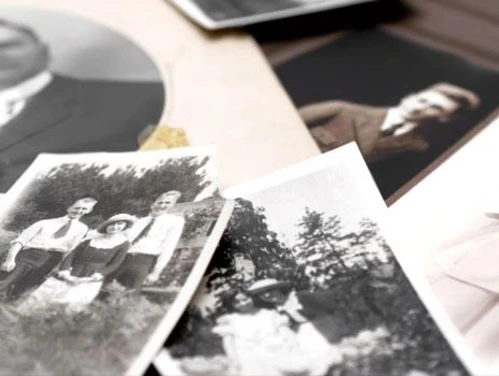On this page...
The following tips will help you to protect and preserve your historic photographs for future generations.
Back to topGeneral Guidelines
- Handle photographs properly by wearing cotton gloves or washing your hands
- Limit exposure to direct light
- Consider displaying duplicate prints rather than original photos. Limit display of originals to three months
- Store photos in archival quality plastic sleeves, albums, or boxes. Do not store photos in wooden cabinets or cardboard boxes as the acid will harm photos
- Buy products that meet the American National Standards Institute (ANSI) standards for photo storage and have passed the Photographic Activity Test (PAT)
- Label photos with a no. 2 pencil or a special photo marking pencil on the back side only
Provide a Moderate and Stable Storage Climate
- High temperatures and relative humidities intensify and speed up the chemical reactions that deteriorate photographs. Fluctuations in temperature and relative humidity contribute to the structural breakdown of photo materials.
- Maintain 35% relative humidity with daily fluctuation of no more than 2% (may need to be slightly higher if books and manuscripts are stored in the same area). Do not exceed 50%. Mold begins to grow at around 60% relative humidity.
- ldeal temperature is 66 degrees with no more than 2 degree daily fluctuation. 68 degrees is considered an acceptable compromise for storage areas where staff are also working. If possible, store color materials and negatives at lower temperatures.
- Store photos away from heaters, washrooms and water pipes, and avoid storage in attics and basements.
- Use humidifiers, dehumidifiers and air conditioners to stabilize climate. Run constantly, 7 days a week, 24 hours a day.
Limit Exposure to Light
- Exposure to light contributes to fading and embrittling of photos by triggering adverse chemical reactions.
- Ultraviolet rays from sunlight and fluorescent lights are especially damaging. Incandescent lights are better for areas where photos are stored and displayed.
- Block out sunlight from windows and use ultraviolet filters on fluorescent light bulbs.
- Exhibit copy prints in place of original photos. If originals are used, minimize exposure to light as much as possible (ex.: drape black cloth over photo which can be lifted for momentary viewing, use U-V filtered Plexiglass and sheeting in display frames and cases).
- Do not display black and white originals for more than 3 months. Display of color materials is not recommended, except under very controlled conditions and strictly limited periods of time.
Protect from Pollutants in the Air
- Photos should not be exposed to fumes or gases from industrial cleaners, insecticides, fresh paint, newly-laid carpet, automobiles, or electrostatic copy machines (ozone). Remove photos from areas prior to painting, re-carpeting or fumigating and wait a couple of weeks before returning them; this will give fumes time to disperse. Use mild, bleach-free cleansers to clean photo areas.
- Protect photos from dirt and dust which can abrade image surfaces and deposit harmful chemicals directly upon the emulsion. Place photos in protective enclosures and practice good housekeeping.
- Use air filtering systems. (Non-electrostatic systems preferable since they do not produce ozone.)
Protect from Pests and Parasites
- Avoid conditions that encourage growth of molds and fungus (high humidities, poor air circulation), or provide enticements for insects and rodents (food, drinks, plants in storage areas).
- Inspect newly-acquired materials for infestations before exposing to the rest of the collection. Isolate suspect materials.
Use Recommended Storage Enclosures and Equipment
- Wooden shelving, cabinets and boxes are not recommended for photo storage since they emit acid-fumes and peroxide gas as they deteriorate. If wooden cabinets and shelving are the only alternative, they should be sealed with several layers of polyurethane varnish, covered with a water-based acrylic paint, or lined with acid-free paper.
- Metal cabinets and shelving should be made of rust-proof, non-corrosive materials such as stainless steel, steel with a baked-enamel paint finish, or anodized aluminum. Regular commercial paper and cardboard, being by-products of wood, are acidic and contain residual elements from the manufacturing process which can harm photos. Many plastic storage enclosures also give off fumes that cause chemical reactions in photo materials. Special products made from acid-free paper and cardboard, and stable plastics (triacetate, polypropylene, polyethylene, polyester) can be purchased from archival supply companies.
- Many photo albums on the market are constructed from harmful adhesives, papers and plastics. “Magnetic” albums, which feature plastic sheeting over gummed pages, are especially damaging. Albums and scrapbooks made of acceptable materials are available through archival supply companies.
Use Care When Processing and Handling
- Cotton gloves should be worn when handling photographic materials to protect them from oils, salt and sulfur present on human skin. At minimum, make sure that hands are clean before handling, and avoid touching the emulsion of the materials (the emulsion side of a negatives is the dull, grainy side).
- Do not use regular ink pens or felt-tips to mark photos. Inks contain sulfur and can “bleed” through photos or migrate to adjacent materials. Use a soft-lead, No.2, pencil, and mark only on the back of the photo. Special marking pens can be purchased through archival suppliers for marking on film or the backs of prints which have waxy surfaces.
- Avoid placing metal fasteners (staples, paper clips, etc.) or rubber bands on photos. Fasteners can rust, tear or indent photographs, while rubber bands can become welded to emulsions.
- Do not apply pressure-sensitive tapes, labels, liquid glues or rubber cement to photos. While wheat and rice starch pastes, or white solid glue sticks, are more acceptable adhesives, it is still preferable to mount photos using methods that do not bring adhesives in direct contact with the photo (ex.: use of archival mounting corners).
